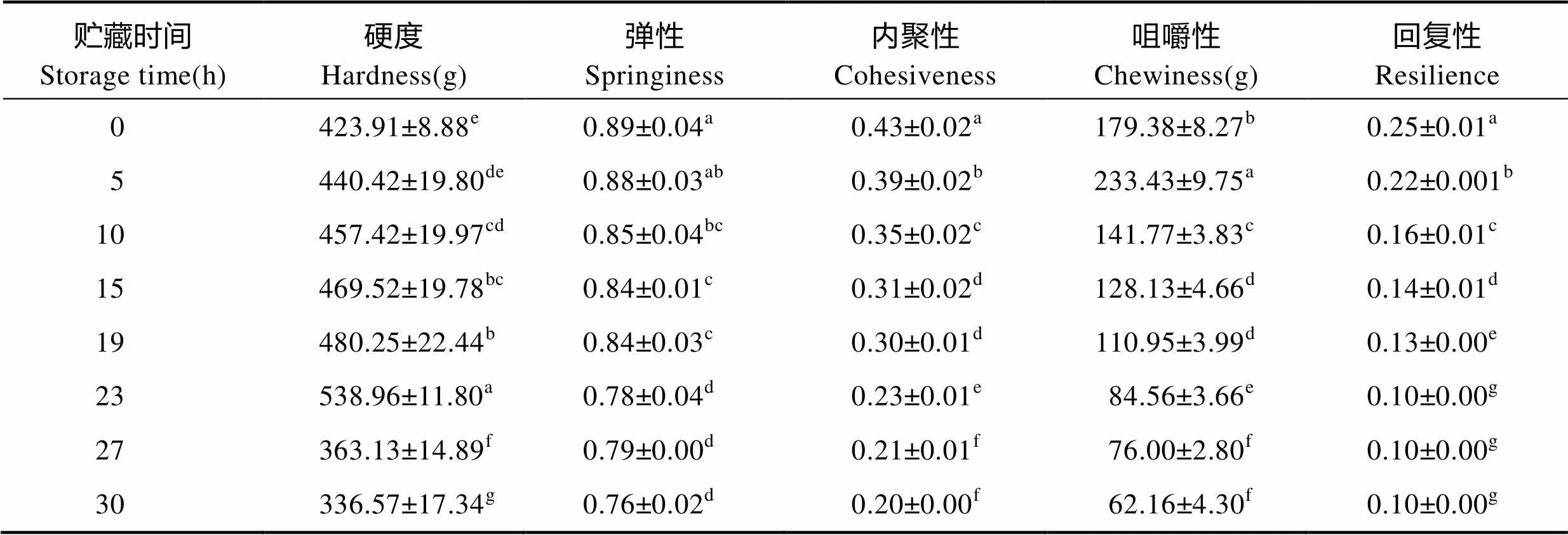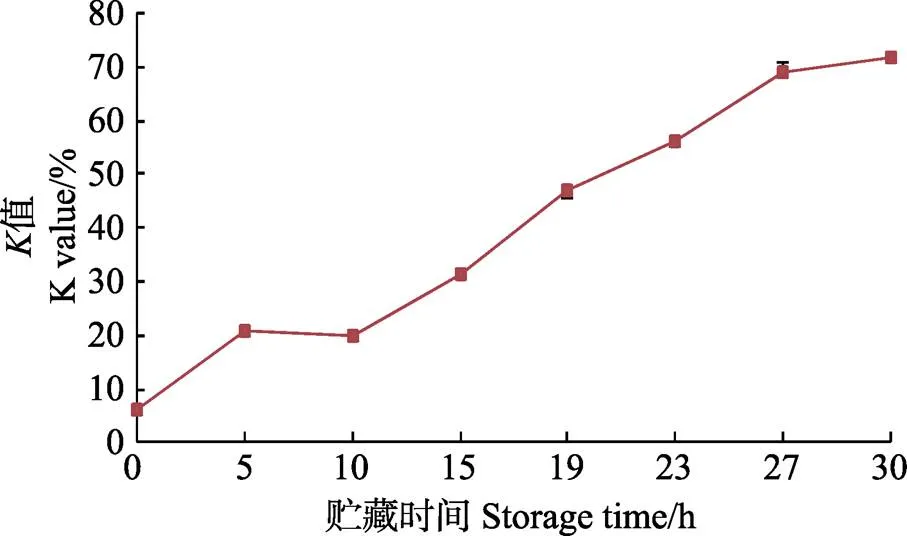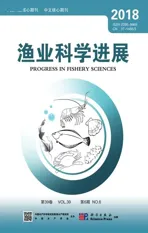草鱼死后常温贮藏过程中的品质变化*
2018-12-19王红丽施文正邱伟强王锡昌
王红丽 施文正 邱伟强 王锡昌
草鱼死后常温贮藏过程中的品质变化*
王红丽 施文正①邱伟强 王锡昌
(上海海洋大学食品学院 国家淡水水产品加工技术研发分中心(上海) 上海 201306)
为了研究草鱼死后常温贮藏过程中的品质变化,以草鱼()背肉为研究对象,测定了草鱼死后30 h内质构、pH、乳酸、游离氨基酸、ATP及其关联化合物等指标的变化。结果显示,草鱼肉的硬度和咀嚼性在死后23 h时达到最大值,弹性、内聚性及回复性均随时间的延长而降低。pH呈先降低后升高的趋势,在23 h达到最大值。乳酸含量则先增加后减少。在整个贮藏过程中,鲜甜味游离氨基酸的总含量逐渐减少,而苦味游离氨基酸的总含量则逐渐增加。ATP含量在草鱼死后10 h内显著增加,具有鲜味的IMP含量则迅速减少,呈苦味的HxR和Hx含量逐渐增加。在整个贮藏过程中,值一直增加。值的变化情况表明,草鱼死后常温贮藏10 h内可保持较高鲜度,27 h时,值达到68.99%,表明鱼肉已经腐败。研究表明,草鱼死后室温贮藏时应在10 h内尽快加工。
草鱼;死后变化;游离氨基酸;ATP及其关联化合物;值
草鱼()是我国主要的淡水经济鱼类,与青、鲢、鳙并称为“四大家鱼”,2016年养殖产量为590万 t (中国渔业年鉴, 2017),居淡水鱼之首。草鱼营养丰富、肉质鲜美,但由于其具有水分含量高、富含营养素、pH中性等特点,货架期相对较短(Abdollahi, 2014)。
鱼死后通常经历4个阶段:初期生化反应、僵硬期、解僵期、自溶与腐败。这些过程发生的快慢以及持续时间与鱼的种类、捕获季节、致死方式、宰前生理状况、贮藏温度、微生物污染等因素有关。Iwamoto 等(1987)比较了0~20℃不同贮藏温度对褐牙鲆()宰后僵直的影响,发现0℃条件下,褐牙鲆宰后3 h开始僵直,15 h僵直达到最大;在5~15℃贮藏时,死后28 h僵直达到最大。Okamoto等(2006)比较了不同季节捕获的三线矶鲈()在0~20℃不同贮藏温度下的僵直情况,结果显示,冬季和夏季捕获的三线矶鲈均是在10℃贮藏时可以延长其僵硬期。
有关鱼类死后变化的研究主要集中在海水鱼类,而淡水鱼死后变化的研究相对较少,且温度多为4℃贮藏(刘晓畅等, 2016)、冰上贮藏(Ocaño-Higuera, 2009)。本研究测定了草鱼死后常温贮藏30 h内质构、pH、乳酸、游离氨基酸、ATP及其关联化合物、值等的变化,旨在丰富鱼类死后变化的基础理论,为草鱼流通过程中的品质控制及保鲜加工提供参考。
1 材料与方法
1.1 材料与试剂
鲜活草鱼购于上海市临港新城古棕路农工商超市,每尾体重为(1600±100) g、体长为(42.5±3.2) cm。
腺嘌呤核苷三磷酸(Adenosine triphosphate, ATP)、二磷酸腺苷酸(Adenosine diphosphate, ADP)、肌苷酸(Inosine monphosphate, IMP)、次黄嘌呤(Hypoxanthine, Hx)(均为色谱纯,Sigma公司,美国);一磷酸腺苷(Adenosine monophosphate, AMP)、次黄嘌呤核苷(Insoine, HxR)(TCI公司,日本);KH2PO4、K2HPO4(色谱纯)4、三氯乙酸(分析纯)、高氯酸、NaOH、KOH(优级纯)(国药集团化学试剂有限公司);17种氨基酸混标(色谱纯)(中国计量科学研究院化学计量与分析科学研究所);乳酸测试盒(南京建成生物工程研究所)。
1.2 仪器与设备
TA-XT Plus型质构仪(Stable Micro System公司,英国);SHP-2500型低温生化培养箱 (上海精宏实验设备有限公司);H2050R型高速冷冻离心机(长沙湘仪有限公司);L-8800型氨基酸自动分析仪(Hitachi公司,日本);W2690/5型高效液相色谱仪(Waters公司,美国);UV-1800PC型紫外-可见分光光度计(上海美谱达仪器有限公司);FE20型pH计(梅特勒-托利多仪器(上海)有限公司)。
1.3 实验方法
1.3.1 原料预处理 鲜活草鱼经充氧运回实验室,采用即杀(重击头部致晕)方式,去除内脏,用流动自来水冲洗干净,沥干后整条装入聚乙烯保鲜袋中,置于25℃培养箱中贮藏。分别在0、5、10、15、19、23、27、30 h时,随机选取3条鱼进行指标测定。
1.3.2 质构的测定 参考马海建(2016)的方法,略作修改。采取横向切片,将样品切成2 cm×2 cm×1 cm大小的肉块。测定模式为TPA,采用P/6平底柱形探头,测试前速率为3.00 m/s,测试速率为1.00 mm/s、返回速率为1.00 mm/s、压缩程度为50%,2次压缩间停留时间为5 s,触发值为5 g,数据采集速率200 pps。每组样品测定8次。
1.3.3 pH的测定 参考吕斌等(2001)的方法,略作修改。称取绞碎、混合均匀的2.0 g鱼肉于离心管中,加18 ml蒸馏水,均质2 min,10000 r/min离心10 min,过滤,取上清液,用pH计测定。
1.3.4 乳酸的测定 采用比色法,按照南京建成生物工程研究所乳酸测试试剂盒说明进行。取2.0 g草鱼背肉,用18 ml 0.85%生理盐水匀浆30 s,4℃条件下匀浆,以10000 g离心10 min,收集上清液,使用双缩脲法(Torten, 2010)测定上清液的蛋白质浓度,用测定试剂盒(No.A019,南京建成生物工程研究所)在530 nm处用分光光度法测定乳酸,结果显示为乳酸/g蛋白质(mmol/g蛋白质)。
1.3.5 游离氨基酸含量的测定 参考陈剑岚等(2017)的方法,略作修改。称取样品2.0 g,加入质量分数为15%的三氯乙酸溶液15 ml,匀浆2 min后,静置2 h,4℃条件下,10000 r/min离心15 min,过滤,取上清液5 ml,用浓度为3 mol/L的NaOH溶液调节pH至2.0,定容至10 ml,摇匀,过0.22 μm膜,滤液上机检测。
1.3.6 核苷酸类化合物含量及值的测定 参考Yokoyama等(1992)的方法,略作修改。称取样品5.0 g置于50 ml离心管中,加入10 ml质量分数为10%的HClO4,高速匀浆2 min,4℃条件下,10000 r/min离心15 min,过滤,取上清液。用5 ml质量分数为5%的HClO4洗涤沉淀,再次离心,合并上清液。调节上清液pH至6.5,静置30 min后,定容至50 ml,摇匀,过0.45 μm膜待测。
高效液相色谱条件:ODS-SP C18色谱柱(4.6 mm× 250 mm,5 μm),ODS-SP保护柱柱芯(4 mm×10 mm,5 μm);流动相A为pH是6.5的0.05 mol/LKH2PO4和K2HPO4(1∶1)溶液,流动相B为甲醇溶液,流速1 ml/min等梯度洗脱;柱温28℃;进样量10 μl;检测波长254 nm。
是ATP降解的产物 HxR和Hx含量之和与ATP关联物总和的百分比(汤水粉等, 2014)。其计算公式:
(%)=(HxR+Hx)/(ATP+ADP+AMP+IMP+HxR+Hx)×100%
式中,ATP、ADP、AMP、IMP、HxR和Hx分别为相应化合物,即腺苷三磷酸、腺苷二磷酸、腺苷酸、肌苷酸、肌苷(次黄嘌呤核苷)和次黄嘌呤的浓度,以μmol/g湿重表示(李辉等, 2011)。
1.4 数据处理
实验数据以3个平行样品的平均值±标准差(Mean±SD)表示,采用SPSS 22.0软件进行数据分析,采用Duncan法进行多重比较,采用Orgin 8.5 (OriginLab Corp, Hampton, 美国)软件绘图。
2 结果与分析
2.1 草鱼死后贮藏过程中质构特性的变化
草鱼死后30 h内硬度、弹性、内聚性、咀嚼性以及回复性的变化见表1。从表1可以看出,鱼肉的硬度可用于评价其新鲜度,刚宰杀的草鱼硬度 为(423.91±8.88) g,在草鱼死后23 h时,硬度达到最大值,为(538.96±11.80) g,随后急剧下降。这与Abe等(1991)的研究结果基本一致。鱼肉的弹性和内聚性均随着时间的延长呈下降趋势,但变化幅度不大。咀嚼性和回复性在贮藏后期下降明显。鱼死后,肌肉质构特性的变化不仅与胶原蛋白等基质蛋白的破坏有关,而且与肌原纤维蛋白的变化有关(Martinez, 2011)。Li 等(2017)研究表明,鱼死后硬度和弹性的变化与pH降低速率和肌原纤维的破坏有关。Sato 等(1991)提出酶的作用也是引起鱼贮藏过程中质构变化的重要因素。Bahuaud等(2010)也发现,大西洋鲑 鱼()组织蛋白酶的作用导致弹性下降。
表1 草鱼死后25℃贮藏过程中质构的变化

Tab.1 Changes in texture of postmortem grass carp during storage at 25℃
注:同列标注不同字母表示差异显著(<0.05),下同
Note: The different superscript letters in the same column indicates significant difference (<0.05),the same as below
2.2 草鱼死后贮藏过程中pH的变化
从图1可知,刚宰杀草鱼的pH为7.26±0.02,高于鲢鱼()的初始pH(史策, 2015)。鱼肉的初始pH值与种类、季节、饲料、死前活动水平以及肌肉类型等因素有关。草鱼死后的30 h内,pH呈先下降后上升的趋势,死后23 h时,下降至6.74±0.02,在30 h时升高至7.15±0.03。刘晓畅 等(2016)研究发现,长丰鲢()宰杀后在4℃条件下,pH在24 h时达到最低值,之后开始升高,与本研究的结果基本一致。草鱼死后pH下降是由于糖原无氧酵解产生乳酸以及ATP和磷酸肌酸等物质逐渐分解产生磷酸所致(Hong, 2012; 熊雄等, 2012)。之后,由于内源酶和鱼肉表面细菌分解蛋白质等含氮化合物,产生碱性物质,导致鱼肉pH逐渐升高(Fan, 2014)。

图1 草鱼死后25℃贮藏过程中pH的变化
2.3 草鱼死后贮藏过程中乳酸含量的变化
从图2可以看出,草鱼死后贮藏过程中,乳酸含量呈先增加后减少的趋势。刚宰杀草鱼的乳酸含量为(1.20±0.08) mmol/g prot,随后逐渐增加,在19 h时达到最大值,为(3.96±0.05) mmol/g prot,23 h后,乳酸含量急剧下降,30 h时,乳酸含量仅为(0.20± 0.02) mmol/g prot。草鱼死后,肌肉中的糖元在无氧条件下经过糖酵解生成乳酸(Poli, 2015),乳酸的生成造成pH降低,导致肌质网积蓄Ca2+的功能下降,Ca2+溶出促进了草鱼死后僵硬的进程(宋永令等, 2010)。

图2 草鱼死后25℃贮藏过程中乳酸含量的变化
2.4 草鱼死后贮藏过程中游离氨基酸含量的变化
游离氨基酸是一类重要的滋味成分,可以呈现出酸、鲜、甜、苦、硫味等,对鱼肉的感官品质有重要影响。鱼死后,肌肉中的蛋白质会发生分解,使游离氨基酸的含量增加,同时,为细菌的生长繁殖创造了有利条件,加速了鱼体的解僵和自溶过程。当鱼肉中的某些游离氨基酸浓度足够高时,能够独立于其他成分对鱼的整体风味起作用(任仙娥等, 2003)。如组氨酸(His)、酪氨酸(Tyr)、赖氨酸(Lys)等具有苦味(施文正等, 2014),天冬氨酸(Asp)、谷氨酸(Glu)、甘氨酸(Gly)、丙氨酸(Ala)等呈鲜味。鲜味氨基酸与呈味核苷酸还具有协同作用(杨阳等, 2015; 陈剑岚等, 2017)。
草鱼死后游离氨基酸含量的变化见表2。从表2可以看出,游离氨基酸总量随贮藏时间的延长呈总体增加的趋势,其中,组氨酸、甘氨酸、丙氨酸含量相对较高。游离氨基酸的呈味作用不仅与绝对含量有关,更与阈值相关。草鱼死后贮藏过程中,组氨酸的含量远高于其阈值(20 mg/100 g),表明对草鱼死后滋味有着重要的作用,而其他种类的游离氨基酸含量均在阈值水平以下。从图3可以看出,草鱼死后贮藏过程中,鲜甜味氨基酸的总含量呈下降趋势,而苦味游离氨基酸的总含量则逐渐增加,这可能与僵硬后期以及自溶和腐败变质阶段鱼肌肉中不同类型的蛋白质降解有关。此外,氨基酸的分解和汁液流失等也会产生一些影响(Erkan, 2011)。

图3 草鱼死后25℃贮藏过程中鲜甜味和苦味氨基酸含量的变化
2.5 草鱼死后贮藏过程中ATP关联化合物及K值的变化
从表3可以看出,刚宰杀的草鱼ATP含量为(3.68±0.37) mg/100 g,在10 h时上升至(12.54±0.41) mg/100 g,随后略微下降。ADP含量变化相对较小。
AMP能抑制苦味,使食品产生理想的咸味与甜味,且与IMP具有协同作用(张佳琪, 2013),草鱼死后,AMP含量在30 h内略有波动,整体呈增加趋势。IMP是重要的鲜味物质(Okamoto, 2006),刚宰杀的草鱼IMP含量较高,随后,在内源性IMP磷酸水解酶和微生物的作用下降解为HxR和Hx;30 h时,IMP含量降至(12.66±0.79) mg/100 g。Hx和HxR具有苦味,其含量在贮藏过程中明显增加,是导致鱼肉整体风味劣化的重要原因。

图4 25℃贮藏条件下草鱼死后过程中K值的变化
草鱼死后30 h内值的变化见图4。从图4可以看出,值是反映鱼死后鲜度变化以及风味相关的生化指标。值一般记为HxR和Hx,二者含量之和与ATP及其关联化合物总量的百分比,值越小说明其鲜度越好。低于20%为非常新鲜,20%~50%为相对新鲜,高于70%时表明已经腐败(Saito, 1959)。本研究中,刚宰杀草鱼的值为6.19%,此后,在贮藏过程中迅速增加,在10 h内鱼肉保持较高鲜度,27 h时值已达到68.99%,表明鱼肉已达到腐败程度。
3 结论
草鱼死后,常温贮藏过程中,鱼肉的硬度和咀嚼性在死后23 h时达到最大值,弹性、内聚性及回复性则随时间的延长呈整体下降趋势。草鱼死后pH迅速降低,23 h时达到最小值,在僵硬后期pH又逐渐增高。乳酸含量呈现先增加后减少的趋势。鲜甜味游离氨基酸的总含量逐渐减少,而苦味游离氨基酸的总含量则逐渐增加,同时,具有鲜味的IMP含量迅速减少,而呈现苦味的HxR和Hx含量则逐渐增加。值的变化情况表明,草鱼死后常温贮藏10 h内可保持较高鲜度,27 h时达到腐败。因此,应尽量在草鱼死后10 h内进行加工。

表3 草鱼死后25℃贮藏过程中ATP及其关联化合物的变化

Tab.3 Changes in ATP-related compounds of postmortem grass carp during storage at 25℃
Abdollahi M, Rezaei M, Farzi G. Influence of chitosan/clay functional bio-nanocomposite activated with rosemary essential oil on the shelf life of fresh silver carp. International Journal of Food Science and Technology, 2014, 49(3): 811–818
Abe H, Okuma E. Rigor-mortis progress of carp acclimated to different water temperatures. Nippon Suisan Gakkaishi, 1991, 57(11): 2095–2100
Anonymous. Fishery yearbook in China in 2017. Beijing: Chinese Agriculture Press,2017 [农业部渔业局. 中国渔业统计年鉴. 北京: 中国农业出版社,2017]
Bahuaud D, Gaarder M, Veiseth-Kent E,. Fillet texture and protease activities in different families of farmed Atlantic salmon (L.). Aquaculture, 2010, 310(1-2): 213–220
Chen JL, Chen SS, Shi WZ,. Study of water-soluble flavor components in fish meat of different size of grass carp. Food and Fermentation Industry, 2017, 43(1): 213–217 [陈剑岚, 陈舜胜, 施文正, 等. 大小草鱼肉呈味水溶性成分的比较. 食品与发酵工业, 2017, 43(01): 213–217]
Erkan N, Uretener G, Alpas H,. The effect of different high pressure conditions on the quality and shelf life of cold smoked fish. Innovative Food Science and Emerging Technologies, 2011, 12(2): 104–110
Fan HB, Luo YK, Yin XF,. Biogenic amine and quality changes in lightly salt- and sugar-salted black carp () fillets stored at 4℃. Food Chemistry, 2014, 159: 20–28
Hong H, Luo Y, Zhou Z,. Effects of low concentration of salt and sucrose on the quality of bighead carp () fillets stored at 4℃. Food Chemistry, 2012, 133(1): 102–107
Iwamoto M, Yamanaka H, Watabe S,. Effect of storage temperature on Rigor-Mortis and ATP degradation in placemuscle. Journal of Food Science, 1987, 52(6): 1514–1517
Li H, Liu LF, Yang BF,. Studies on the texture and rheological properties ofunder controlled freezing point storage. Progress in Fishery Sciences, 2011, 32(03): 63–68 [李辉, 刘莲风, 杨博峰, 等. 冰温保鲜条件下牙鲆的鲜度及质构变化. 渔业科学进展, 2011, 32(3): 63–68]
Li Q, Zhang LT, Lu H,. Comparison of postmortem changes in ATP-related compounds, protein degradation and endogenous enzyme activity of white muscle and dark muscle from common carp () stored at 4℃. Food Science and Technology, 2017, 78: 317–324
Liu XC, Jiang Y, Shen S,. Postmortem changes of Changfeng sliver carp during storage at 4℃. Meat Research, 2016, 30(5): 20–24 [刘晓畅, 蒋妍, 申松, 等. 4℃冷藏条件下长丰鲢尸僵过程中的品质变化规律. 肉类研究, 2016, 30(5): 20–24]
Lü B, Chen SS, Deng DW. Variations of glycogen, lactic acid content and pH value in muscle of three species of cultured freshwater fishes during storage. Journal of Shanghai Fisheries University, 2001, 10(3): 239–242 [吕斌, 陈舜胜, 邓德文. 三种淡水鱼肌肉的糖元、乳酸含量和pH值及在冷藏中的变化. 上海水产大学学报, 2001, 10(3): 239–242]
Ma HJ. Effects of ultra-high pressure treatment on the quality of grass carp meat and surimi. Master’s Thesis of Shanghai Ocean University, 2016 [马海建. 超高压处理对草鱼鱼肉和鱼糜制品品质的影响. 上海海洋大学硕士研究生学位论文, 2016]
Martinez I, Wang PA, Slizyte R,. Protein expression and enzymatic activities in normal and soft textured Atlantic salmon () muscle. Food Chemistry, 2011, 126(1): 140–148
Ocaño-Higuera VM, Marquez-Ríos E, Canizales-Dávila M,. Postmortem changes in cazon fish muscle stored on ice. Food Chemistry, 2009, 116(4): 933–938
Okamoto A, Hamada Y, Miura K,. Influence of killing procedures and storage temperatures on post-mortem changes in the muscle of cultured three-line grunt. Nippon Suisan Gakkaishi, 2006, 72(5): 918–923
Poli BM, Parisi G, Scappini F,. Fish welfare and quality as affected by pre-slaughter and slaughter management. Aquaculture International, 2005, 13(1–2): 29–49
Ren XE, Zhang SH. The research status of fish flavor. China Condiment, 2003, 28(12): 17–21 [任仙娥, 张水华. 鱼肉风味的研究现状. 中国调味品, 2003, 28(12): 17–21]
Saito T, Arai K, Matsuyoshi M. A new method for estimating the freshness of fish. Bulletin of the Japanese Society of Scientific Fisheries, 1959, 24(9): 749–750
Sato K, Ohashi C, Ohtuki, K,. Type V collagen in trout () muscle and its solubility change during chilled storage of muscle. Journal of Agriculture and Food Chemistry, 1991, 39(7): 1222–1225
Shi C. Changes of the ATP-related compounds and biochemical properties of silver carp during early stage post-mortem and chilled storage. Doctoral Dissertation of China Agricultural University, 2015 [史策. 鲢鱼尸僵及贮藏过程中ATP关联物及生化特性变化规律的研究. 中国农业大学博士研究生学位论文, 2015]
Shi WZ, Chen QY, Wan JQ,. Effect of frozen on freshness and taste of grass carp mea. Food Industry Technology, 2014, 35(16): 334–336, 341 [施文正, 陈青云, 万金庆, 等. 冷冻对不同部位草鱼肉鲜度和滋味的影响. 食品工业科技, 2014, 35(16): 334–336, 341]
Song YL, Luo YK, Zhang LN,. Study on bream () quality variation during storage under different temperatures. Journal of China Agricultural University, 2010, 15(4): 104–110 [宋永令, 罗永康, 张丽娜, 等. 不同温度贮藏期间团头鲂品质的变化规律. 中国农业大学学报, 2010, 15(4): 104–110]
Tang SF, Qian ZZ, Luo FF,. Determination of ATP-related compounds in aquatic products by high performance liquid chromatography. Progress in Fishery Sciences, 2014, 35(2): 110–116 [汤水粉, 钱卓真, 罗方方, 等. 高效液相色谱法测定水产品中ATP关联化合物. 渔业科学进展, 2014, 35(2): 110–116]
Torten J, Whitaker JR. Evaluation of the biuret and dye-binding methods for protein determination in meats. Journal of Food Science, 2010, 29(2): 168–174
Xiong X, Peng ZQ, Jin HG,. Changes in muscle pH and rigor index of big head carp during ice storage and their effects on gel properties of salt-soluble proteins from big head carp. Journal of Food Science, 2012, 33(9): 87–90 [熊雄, 彭增起, 靳红果, 等. 鳙鱼宰后pH 值和僵直指数的变化及其对盐溶蛋白凝胶特性的影响. 食品科学, 2012, 33(9): 87–90]
Yang Y, Shi WZ, Wang ZH,. Effect of ultra-high pressure on the flavor of cooked white shrimp meat. Food Industry Technology, 2015, 36(18): 87–92, 98 [杨阳, 施文正, 汪之和, 等. 超高压对南美白对虾熟制虾仁风味的影响. 食品工业科技, 2015, 36(18): 87–92, 98]
Yokoyama Y, Sakaguchi M, Kawai F,. Change in concentration of ATP-related compounds in various tissues of oyster during ice storage. Nippon Suisan Gakkaishi, 1992, 58(11): 2125–2136
Zhang JQ. A simplified method for extration of ATP related compounds in fish meat and its application. Master’s Thesis of Zhejiang University, 2013, 2–4 [张佳琪. 鱼肉中ATP 关联化合物提取方法的改进及应用. 浙江大学硕士研究生学位论文, 2013, 2–4]
Quality Changes of Grass Carp () in the Process of Postmortem Stored at Room Temperature
WANG Hongli, SHI Wenzheng①, QIU Weiqiang, WANG Xichang
( College of Food Science and Technology, National R&D Branch Center for Freshwater Aquatic Products Processing Technology (Shanghai), Shanghai Ocean University, Shanghai 201306)
In order to study the quality changes of grass carp during postmortem at room temperature (25℃), the changes in texture, pH, lactic acid, free amino acids, and ATP-related compounds in the dorsal meat of grass carp were measured using texture analyzer, pH meter, lactic acid kit, automatic amino acid analyzer, and high-performance liquid chromatography method in the postmortem process within 30 h. The results showed that hardness and chewiness of the grass carp reached its maximum at 23 h and then rapidly decreased, while springiness, cohesiveness, and resilience of grass carp decreased with the extension of storage time. pH showed a trend of decreasing first and then increasing, and it reached its maximum at 23 h. The content of lactic acid increased initially and then decreased, which reached its minimum value at 23 h.The total amount of fresh sweet amino acids gradually decreased during the postmortem process, while bitter amino acids were just the opposite, which increased during the postmortem process. The content of ATP increased significantly within 10 h, while the content of IMP with umami taste decreased rapidly1. Furthermore, the content of HxR and Hx with bitter taste increased gradually during the storage process. The K value increased during the postmortem process. The change invalue indicated that grass carp could maintain high freshness after storage for 10 h at room temperature, and it reached 68.99% at 27 h, which showed that the fish had spoiled at that time. Therefore, it should be processed as soon as possible, ideally within 10 hours after the death of grass carp at room temperature. This study will enrich the basic theory of postmortem variation of fish and provide support for the quality change of aquatic products.
; Postmortem; Free amino acids; ATP-related compounds;-value
SHI Wenzheng , Email: wzshi@shou.edu.cn
王红丽, 施文正, 邱伟强, 王锡昌. 草鱼死后常温贮藏过程中的品质变化. 渔业科学进展, 2018, 39(6): 97–105
Wang HL, Shi WZ, Qiu WQ, Wang XC. Quality changes of grass carp () in the process of postmortem stored at room temperature. Progress in Fishery Sciences, 2018, 39(6): 97–105
* 国家自然科学基金面上项目(31471685)资助[This work was supported by the National Natural Science Foundation of China (31471685)]. 王红丽,E-mail: 18221338903@163.com
施文正,教授,E-mail: wzshi@shou.edu.cn
2018-08-10,
2018-08-14
10.19663/j.issn2095-9869.20180810003
TS254.7
A
2095-9869(2018)06-0097-09
(编辑 陈辉)
